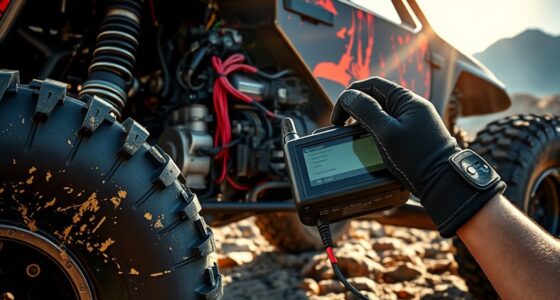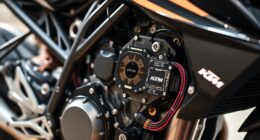Regenerative braking mainly works on flat, paved roads where traction is reliable. On loose terrain, reduced grip and wheel slip make it tough for the system to recover energy effectively. Stability and control become more challenging, limiting braking performance and energy capture. While vehicle design and advanced controls help, regenerative braking faces significant hurdles off-road. If you want to explore how to optimize safety and efficiency in such conditions, you’ll find useful insights ahead.
Key Takeaways
- Regenerative braking relies on traction, which decreases on loose terrain, reducing energy recovery efficiency.
- Wheel slip on uneven surfaces can cause unpredictable braking and limit energy transfer.
- Vehicle design features like traction tires and advanced suspension improve off-road regenerative braking.
- Technologies such as terrain-aware systems and traction control help mitigate loose terrain challenges.
- Proper driving techniques, including smooth, gradual braking, enhance safety and energy recovery on loose surfaces.
How Regenerative Braking Works in Standard Conditions
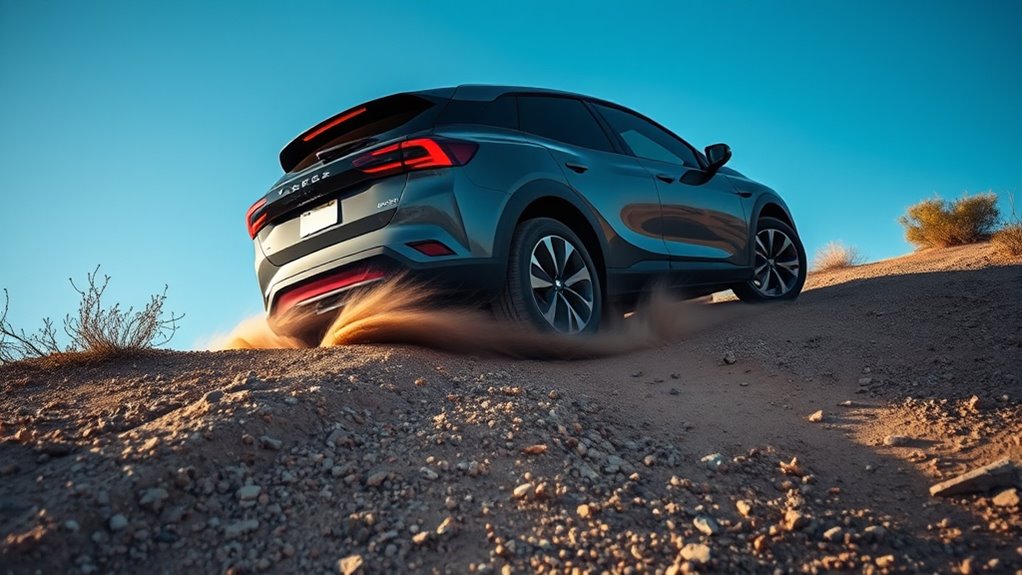
Regenerative braking in standard conditions works by converting the kinetic energy of a moving vehicle into electrical energy when you press the brake pedal. Instead of using traditional brake pads that dissipate energy as heat, your vehicle’s electric motor switches into a generator mode. This process slows the vehicle down while capturing energy that would otherwise be lost. The motor’s rotation generates electricity, which is then stored in the vehicle’s battery for later use. This method not only improves efficiency but also reduces brake wear. You’ll notice smoother deceleration and less frequent brake maintenance. Regenerative braking is especially effective on flat, paved roads, where consistent friction and predictable conditions allow it to operate at its most effective. It’s an essential feature in many electric and hybrid vehicles for maximizing energy recovery. Environmental considerations play a role in the effectiveness of regenerative braking systems, as they promote sustainable driving practices.
Challenges of Implementing Regenerative Braking on Loose Surfaces

Implementing regenerative braking on loose surfaces presents unique challenges because the system relies heavily on consistent traction and predictable wheel behavior. On loose terrain, wheels tend to slip or lose grip more easily, making it difficult to recover energy effectively. Sudden wheel spin can prevent the system from engaging properly, reducing energy recovery efficiency. Additionally, uneven grip can cause inconsistent deceleration, leading to unpredictable braking performance. The system may also misinterpret wheel slip as a need for more braking force, risking skidding or loss of control. These issues demand advanced control algorithms and real-time adjustments to adapt to changing traction conditions. Without these adaptations, regenerative braking becomes less reliable, limiting its effectiveness and safety on loose surfaces. Furthermore, traction management is essential to optimize system performance and ensure safety in such environments.
Impact of Terrain Type on Energy Recovery Efficiency

Your terrain’s surface friction directly affects how much energy your regenerative braking system can recover. On unstable or loose surfaces, reduced traction diminishes braking efficiency and energy capture. Understanding these terrain stability factors helps optimize recovery performance across different environments. Additionally, the type of terrain can influence the vehicle’s handling and safety, which may indirectly impact braking effectiveness.
Surface Friction Effects
The type of terrain considerably influences the effectiveness of regenerative braking on loose surfaces. Surface friction plays a critical role in how well your braking system can recover energy. On loose terrain, reduced friction means less resistance, which limits the ability of regenerative brakes to slow your vehicle effectively while capturing energy. Lower friction surfaces, such as gravel or sand, decrease contact between tires and ground, making it harder to generate the necessary braking torque.
- Reduced friction diminishes energy recovery potential
- Loose surfaces require more conventional braking for safety
- Friction variability affects braking consistency and efficiency
Understanding these effects helps you anticipate how much energy you can recover and when to rely more on traditional braking methods.
Terrain Stability Impact
Since terrain stability directly affects how well regenerative braking works, unstable surfaces like loose gravel or mud reduce energy recovery efficiency. When the terrain shifts under your wheels, it disrupts the contact needed for effective energy transfer during braking. On loose surfaces, your vehicle’s wheels may slip or slide, preventing ideal deceleration and limiting the energy that can be captured. Muddy or uneven terrain further complicates this, as inconsistent grip causes unpredictable braking responses. This instability means your vehicle can’t maintain steady deceleration, reducing the amount of kinetic energy converted into electrical energy. As a result, the regenerative system can’t operate at peak efficiency. Traction and grip play a crucial role in maintaining stable braking performance on different terrains. To maximize energy recovery, smooth, firm surfaces allow for better traction and more consistent braking performance.
Vehicle Design Features Affecting Off-Road Regenerative Braking

Your vehicle’s off-road suspension and tire traction substantially influence regenerative braking efficiency on loose terrain. Well-designed suspension helps maintain stability, allowing better energy capture during braking. Meanwhile, tires with superior traction ensure more effective deceleration without slipping, maximizing energy recovery. The use of specialized self-watering plant pots in vehicle components, such as moisture-sensitive systems, exemplifies how moisture control can enhance overall performance in challenging environments.
Off-Road Suspension Design
Off-road suspension design plays a crucial role in enabling effective regenerative braking on loose terrain. It helps absorb shocks, maintain tire contact, and ensure vehicle stability, all of which are critical for consistent braking performance. A well-designed suspension system prevents excessive wheel lift or bounce, which can disrupt regenerative energy flow. It also allows for better control over brake force distribution, especially on uneven surfaces. Remember, the suspension’s ability to adapt to varying terrain conditions directly impacts the efficiency of energy recovery during braking. To maximize regenerative capabilities, focus on suspension features like:
- Adjustable damping settings for different terrains
- Long-travel suspension to accommodate rough surfaces
- Robust components to withstand harsh off-road conditions
- Proper water park maintenance to ensure ride safety and performance.
Tire Traction Impact
How does tire traction influence regenerative braking on loose terrain? Tire traction is vital because it determines how well your tires grip uneven, slippery surfaces. On loose terrain like gravel or sand, low traction means your tires can slip when you apply brakes, reducing regenerative braking efficiency. If your tires can’t maintain enough grip, the system might switch to traditional braking to prevent skidding, limiting energy recovery. High-traction tires, such as those with deep treads or specialized off-road compounds, help maintain better contact with the ground, allowing regenerative braking to work more effectively. Choosing tires designed for off-road conditions can enhance your vehicle’s ability to recover energy while maintaining control, even on challenging surfaces. Traction directly impacts how much regenerative braking you can harness on loose terrain. Additionally, understanding Gold IRA Rollovers can be a strategic way to diversify your investment portfolio, offering a hedge against market volatility and inflation.
Techniques for Maximizing Safety and Effectiveness Off-Road
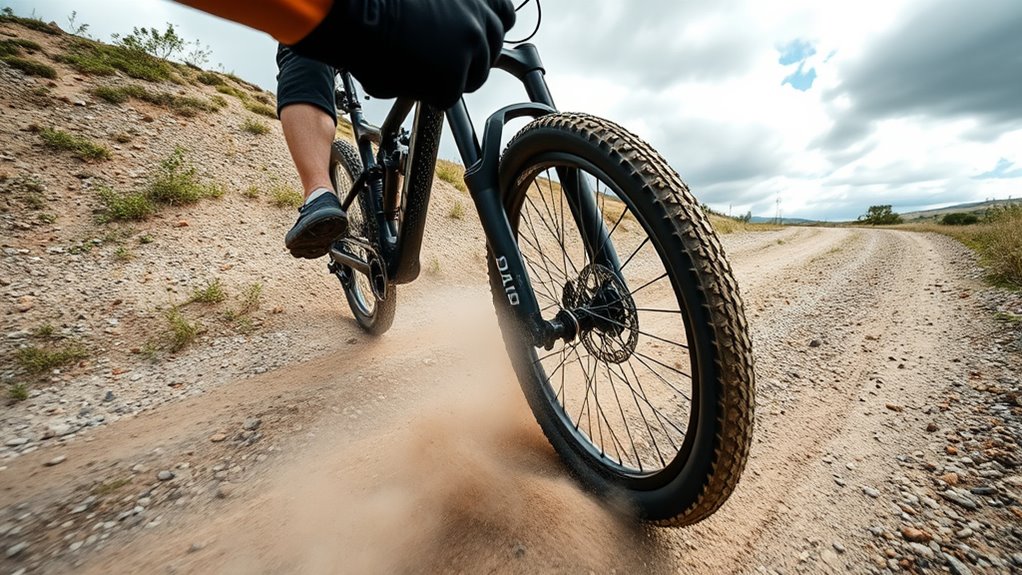
To maximize safety and effectiveness when using regenerative braking on loose terrain, it’s essential to adopt driving techniques suited for unpredictable surfaces. Maintain a gentle, steady throttle to prevent sudden shifts that could cause loss of control. Anticipate changes in terrain, braking early to avoid abrupt stops that might destabilize your vehicle. Use light, progressive braking to let regenerative systems assist without overwhelming traction.
Remember these key points:
- Keep a relaxed grip on the steering wheel to stay responsive
- Modulate brake pressure smoothly to avoid skidding
- Adjust your speed proactively before encountering loose patches
Applying these techniques helps you harness regenerative braking effectively while minimizing risks on challenging off-road surfaces.
Current Technologies and Innovations Addressing Off-Road Limitations
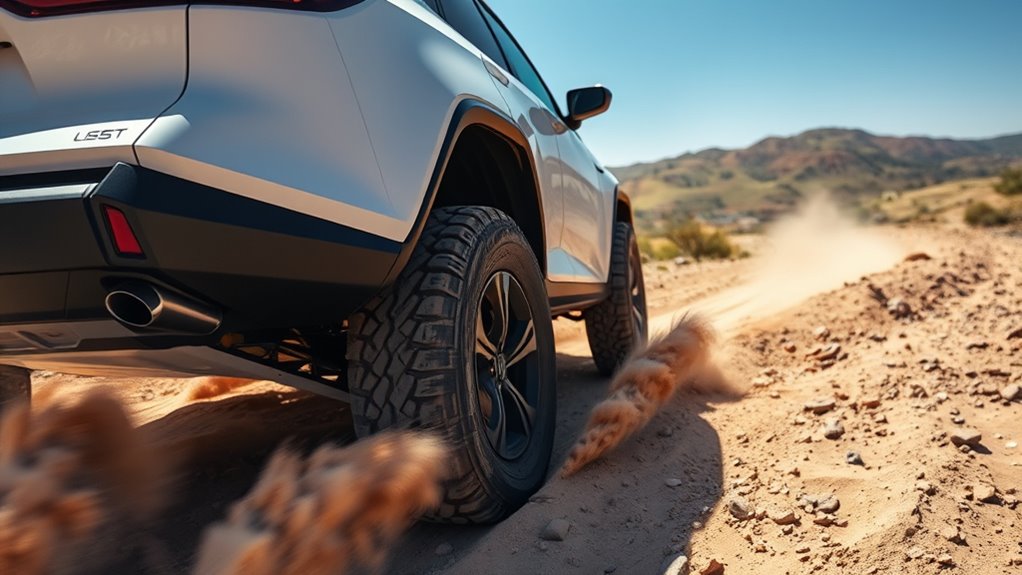
Advancements in vehicle technology are increasingly overcoming the limitations of regenerative braking on challenging terrains. Engineers are developing systems that adapt to loose surfaces, improving energy recovery and control. Innovations include terrain-aware brake management, which adjusts regenerative force based on surface feedback, and enhanced traction control systems that prevent wheel slip. Additionally, new battery and motor designs allow for better energy storage during uneven braking. These technologies work together to optimize braking performance off-road. To illustrate, consider the following advancements:
| Technology | Function | Benefit |
|---|---|---|
| Terrain-Adaptive Brakes | Adjusts regenerative force based on terrain | Prevents wheel slip, improves control |
| Enhanced Traction Control | Manages wheel slip during braking | Maintains stability |
| Advanced Battery Systems | Stores energy efficiently on uneven surfaces | Extends range, improves recovery |
| Smart Sensor Integration | Detects terrain type in real-time | Optimizes braking response |
| Motor Control Algorithms | Fine-tunes regenerative braking force | Enhances off-road safety |
Practical Tips for Drivers Using Regenerative Braking on Uneven Terrain
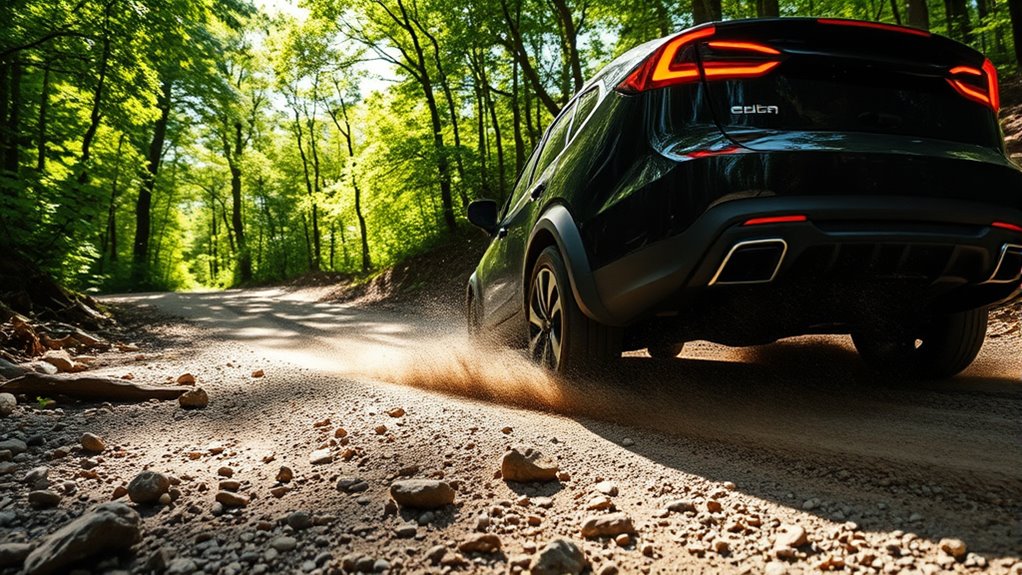
Contending with uneven terrain with regenerative braking requires you to stay attentive and adapt your driving style. Keep your movements smooth to prevent abrupt deceleration that can cause loss of control. Anticipate obstacles and adjust your speed early to maximize braking efficiency. Use gentle, progressive braking instead of sharp stops, which helps conserve energy and maintains vehicle stability. Being aware of dog names, such as those inspired by culture or breed-specific traits, can be useful if you’re navigating areas with pet activity or pet-friendly zones.
Frequently Asked Questions
Can Regenerative Braking Be Used Effectively in Icy or Snowy Conditions?
You might wonder if regenerative braking works well on icy or snowy roads. It can be effective if your vehicle’s system is designed to adapt to low-traction conditions. However, you should be cautious because sudden regenerative braking can cause wheel lock or skidding on slippery surfaces. Use gentle, controlled braking and consider disengaging regenerative mode if your vehicle offers that option for better safety in icy conditions.
How Does Loose Gravel Affect Regenerative Braking System Performance?
Imagine your car gliding over a bed of loose gravel like a leaf floating on water. The gravel acts like tiny marbles under your wheels, causing slippage. This reduces the efficiency of the regenerative braking system, much like trying to catch water with a leaky bucket. The system struggles to recover energy because the grip isn’t firm, making braking less effective and less able to convert kinetic energy into usable electrical power.
Are There Specific Vehicle Modifications for Better Off-Road Regenerative Braking?
You can improve off-road regenerative braking by adding specific modifications like rugged tires for better traction, upgraded suspension for stability, and enhanced braking systems designed for uneven terrain. Installing off-road sensors and controllers helps optimize energy recovery on loose surfaces. These upgrades guarantee your vehicle can efficiently harness braking energy, even on challenging terrains, making your off-road adventures safer and more energy-efficient.
What Maintenance Is Required for Regenerative Brakes on Rugged Terrains?
You might think regenerative brakes need little maintenance, but on rugged terrains, they demand regular checks. Investigate whether debris, mud, or dust affects their efficiency—these elements can clog components or reduce effectiveness. You should inspect brake pads, wiring, and sensors frequently, cleaning and replacing parts as needed. Proper maintenance guarantees your regenerative braking system functions at its best, especially when steering through challenging, loose terrains where reliability is vital.
How Do Driver Techniques Influence Regenerative Braking Efficiency Off-Road?
Your driving techniques greatly influence regenerative braking efficiency off-road. By maintaining steady speeds and avoiding sudden stops or accelerations, you help the system recover more energy effectively. Using gentle braking instead of abrupt stops allows the regenerative system to work ideally. Being mindful of terrain changes, like loose or uneven surfaces, helps you anticipate braking needs, ensuring you maximize energy recovery while maintaining control and safety during your off-road adventures.
Conclusion
While regenerative braking is highly effective on smooth roads, its efficiency drops on loose terrain due to reduced traction. Did you know that off-road vehicles with specialized regenerative systems can recover up to 20% less energy compared to on-road models? By understanding terrain challenges and using proper techniques, you can maximize safety and energy recovery. Keep exploring innovative tech and stay cautious—your off-road adventures can still benefit from regenerative braking, even on uneven, loose surfaces.




